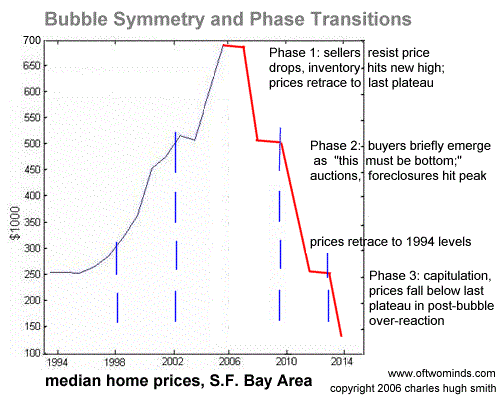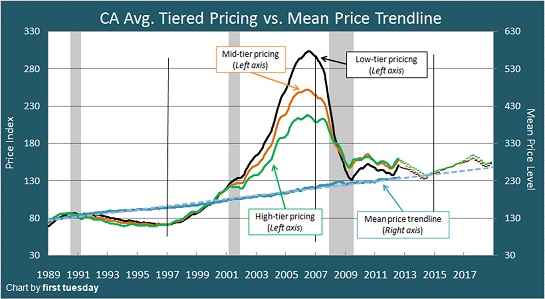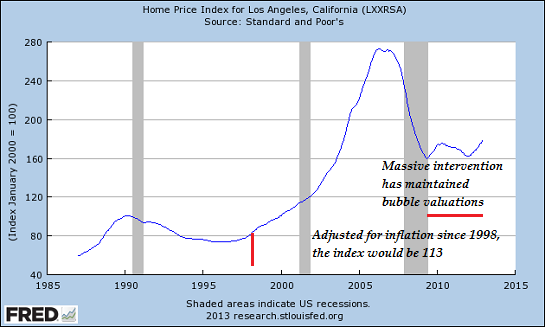If bubbles eventually revert to their starting level, Phase 3--capitulation and a return to pre-bubble prices--still lies ahead for the housing market.
Way back in 2006 at the height of the housing bubble, this chart was prepared proposing the housing bubble might exhibit symmetry, i.e. the decline would mirror the rise. I also proposed that the decline would be characterized by phase shifts that corresponded to the decay of whatever reason was being given for the "recovery" in housing, for example, "this must be the bottom."

Let's compare this idealized bubble symmetry with a chart from reality: housing in the bubblicious Los Angeles market.

Here's another look at the L.A. market as measured by Standard & Poors:

Hmm, what would have happened if the Federal Reserve hadn't dumped trillions of dollars into the mortgage market, and the Federal housing agencies hadn't subsidized mortgages and housing with 3% down payments and tax credits?
Perhaps all the trillions of dollars of intervention has accomplished is extend Phase 2. Central bank and state manipulation distorted the symmetry of housing's decline, but did they stave off Phase 3 permanently?
If bubbles eventually revert to their starting level, Phase 3--capitulation and a return to pre-bubble prices--still lies ahead.
Let's compare the idealized bubble symmetry chart above with a chart from reality: housing in the bubblicious Sydney Australian market.
When the banks are finally forced to push the houses off their books then we will find a natural bottom. As long as they can keep them on the books we will keep up this game until every neighborhood looks like Detroit. The bank will have vacant houses that are ready to fall over on their books valued at $100,000 +.
Bubbles never end pretty...that's the sin quo non of "bubble mania." One needs to take on the traders mindset when investing in Real Estate also (buy low/ sell high)
Some Australians have managed a solid exit by marketing their Real Estate heavily to the Chinese because they're not all that familiar with the Ponzi game. It becomes the lure of it all; they start to try and out-compete each other. I have to constantly remind my Japanese wife that "sale" (or, "cheap") doesn't mean "value." Such people are easy to set up as lemmings. BUT... nearly everyone is or has been in the lemming pool; those that left learned what "bigger sucker" means. And, as is always the case, there's always the end of the line, the last sucker. This time it's the Chinese, as there are no other suckers around. And to be a non-resident AND from a country that is increasingly shifting toward the bad-guys list, well...
The Japanese tried that once and it didn't turn out so good for them. Let's see if the chinese are any smarter.
when it comes to housing, people think they're buying a house when what they are really buying is a monthly payment. Remove the Fed from what we laughably like to call the bond market and require the Federal Government to compete for financing and the resultant increase in rates would crush the housing market. You'd see prices fall to levels last seen in the late 80s.
The trick is to identify a bubble and not participate because while the idea of a fast buck is appealing, the downside is worse.
Remember the secret to making money in any market is not to lose money, your gains will come over time but losing is hard to overcome.
Does That Australian Housing Bubble Chart Remind You Of Anything?
Most bubbles take on the form of the chart you see here when normal assets take on a life of their own and become something you must own ONLY because it has to go higher, right? wrong!
Most bubbles take on the form of the chart you see here when normal assets take on a life of their own and become something you must own ONLY because it has to go higher, right? wrong!



No comments:
Post a Comment